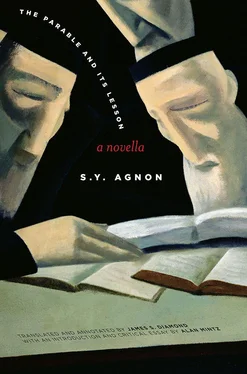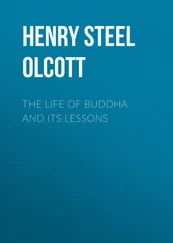This speculation gives birth to another speculation. The depiction of the rabbi comes to us wholly through the eyes and lips of the shamash, who selects behaviors, incidents and quotations in order to construct the figure of his venerated master. The shamash lives long into the period of Buczacz’s reconstruction and prosperity even as he observes disturbing signs of spiritual complacency in matters concerning which he knows there are dire consequences. Might not the shamash have exercised a preemptive prophetic wisdom on behalf of the rabbi? Might not the parables that concluded the rabbi’s long discourse have been “retrofitted” through the work of the imagination to yield an older wisdom that would have the éclat of prophetic authority when they would be most needed?
Whatever their etiology, the parables can in no meaningful sense be construed to constitute the climax of the story, or the distillation of its meaning, or the banner under which the reader first encounters the text. As a title, The Parable and Its Lesson [ Hamashal vehanimshal ] is a decoy or a counter that draws our attention away from the unstable and contending binaries of the story.
THE HOLY COMMUNITY OF BUCZACZ
As the shamash concludes his tale and the narrator resumes direct narration of the story, a new character moves to center stage: the holy community of Buczacz. One of the great questions that haunts Agnon’s epic cycle of Buczacz stories as a whole is whether a community can in fact be conceived of as a character and function like one. Can a social organism exercise the will and agency that we associate with the great figures of fiction? Can a town meaningfully function as the protagonist of a formidable cycle of stories? ‘Ir umelo’ah is the large canvas on which Agnon experiments with this proposition. Although we can reckon with these questions only by taking the whole cycle into account, the final sections of our story give us a glimpse how this collective portraiture might work.
The last four chapters of the story (24–27) present a complex picture of how the community of Buczacz absorbs and processes the extraordinary new information revealed by the shamash’s tale. Throughout these pages, Buczacz is spoken about as a single collective, as when the narrator begins Chapter 24 with the statement “The shamash’s words left Buczacz astounded” ( ‘amdah Bitshatsh temihah , 58); or when verbs in the third person plural are used to convey concerted action on the part of the inhabitants of the town as a whole. Although the distinct behavior of some subgroups is pointed out, the corporate identity of Buczacz is maintained throughout.
The first response of Buczacz is cognitive disorientation. It was always taken for granted that “talking generally brings people together and dispels worry, while silence is usually a sign of sorrow and suffering” (58–59), and now this commonsense conviction has been powerfully refuted. Dealing with the contradiction brings out the dialectical acumen of the town, and it is in the course of their arguments that they come to admit the logic of the shamash’s arguments and acknowledge how even learned human discourse can become an affront to God’s honor and generosity. After having grasped the point intellectually, they begin to confront the dread and anxiety that inevitably follow in the wake of this realization.
A series of groans came forth from the assembled. First from despair, and then from trepidation, for even when one takes care not to talk during the services or the Torah reading, there are times when one simply cannot control oneself and things that serve purposes neither lofty nor base come out. (59)
Reviewing their Sabbath morning practices with an honest eye, the townspeople are constrained to admit that rarely a week goes by when some words of the Torah reading are not drowned out or otherwise lost by well-meaning (or sarcastic) remarks correcting the reader and by the commotion they provoke.
Within this general spiritual reckoning, there are those who are especially receptive to this heightened stringency because they have already intuited its truth but not yet grasped its enormity. They not only immediately take upon themselves the rule of silence in synagogue but, in a way that would have gratified the shamash’s master Rabbi Moshe, also extend the principle of avoiding unnecessary speech to behavior in the marketplace and in the home. At the same time, there are others in the community who, while accepting the validity of the new stricture, give themselves over to an obsessive and even lurid fascination with the details of Gehinnom. Are there fallen angels there? Are the tortures interrupted on the Sabbath? Do they say the same prayers we do? What happens to their clothes and their fringed undergarments after their bodies cease to exist? “There was no end to their questions,” the narrator informs us, “and because they had not yet learned to restrain their tongues, those tongues nattered on with abandon” (61). Absorbed in the sensational revelations of the shamash’s tale, they have allowed the real import of the story to pass by them.
Yet, in the final analysis, the townspeople of Buczacz do the right thing. They recognize that the shamash’s precipitating act of public humiliation was in fact a gesture of self-sacrifice, and instead of fining him and removing him from his office, they restore him to public honor and give him the special task of standing on the bimah during the Torah reading and vigilantly surveying the congregation for errant instances of idle chatter. This is but one instance of the procedures and safeguards the elders put into effect so that the new discipline will be made a permanent part of the religious life of the town.
The willingness of Buczacz to rectify its ways, in other words, gives the story a happy ending, at least in the classic sense in which the bonds of society are reconstituted after a threat to their cohesion. It remains unclear, however, whether the positive ending outweighs the grave instances of suffering so strongly adduced earlier in the story concerning the aftermath of 1648 and in the compartments of Gehinnom. These two sources of tragic undertow, we have seen, contend at every level of the story with the moral issue of divine and human speech, the former the result of ungovernable forces and the latter more susceptible to human agency. Through his narrator, Agnon formerly converts the story into a comedy by devoting the final chapters to the successful repentance of the town. In metaphysical and aesthetic terms, however, the ending comes across as less of a consummation than an act of will. To the threat posed by the corrosive and deconstructive forces of unexplained suffering — in this world and the next — the story offers the example of Buczacz as a qehilah qedoshah , a holy community that is imperfect but capable of religious renewal.
In the privileging of religious rationality in the concluding chapters of the story, some readers may find a disappointing falloff in aesthetic interest. For after the melodrama of a court trial and a descent into Hell, the efforts to reform synagogue protocols may seem lacking in dramatic moment, or smacking of a tacked-on happy ending. Yet this ending, on closer inspection, turns out to be less than wholly consummate and accomplished. Although the community makes amends and institutes many reforms, the spirit of those corrections are eclipsed over time by the realities of communal life. Synagogues cannot subsist without contributions from congregants, and these are generally made when a man is called to the Torah and given the opportunity to have blessings publicly recited for the well-being of the members of his household. In a sardonically funny passage (64), the narrator catalogues the many ways in which this seemingly benign practice can result in propagating waves of distraction and animosity. This report on the equivocal fate of the reforms over time not only reconfirms the narrator’s reliability as a jaundiced observer but also leavens the story’s positive resolution by grounding it in the realities of human nature and communal behavior.
Читать дальше












![Edward Ellis - Adrift on the Pacific - A Boys [sic] Story of the Sea and its Perils](/books/753342/edward-ellis-adrift-on-the-pacific-a-boys-sic-s-thumb.webp)